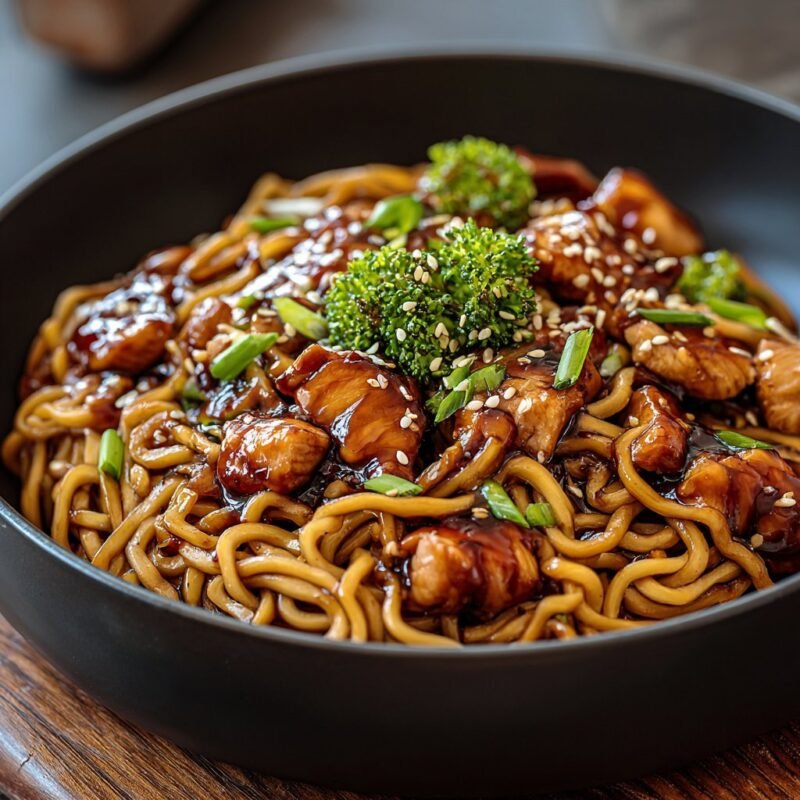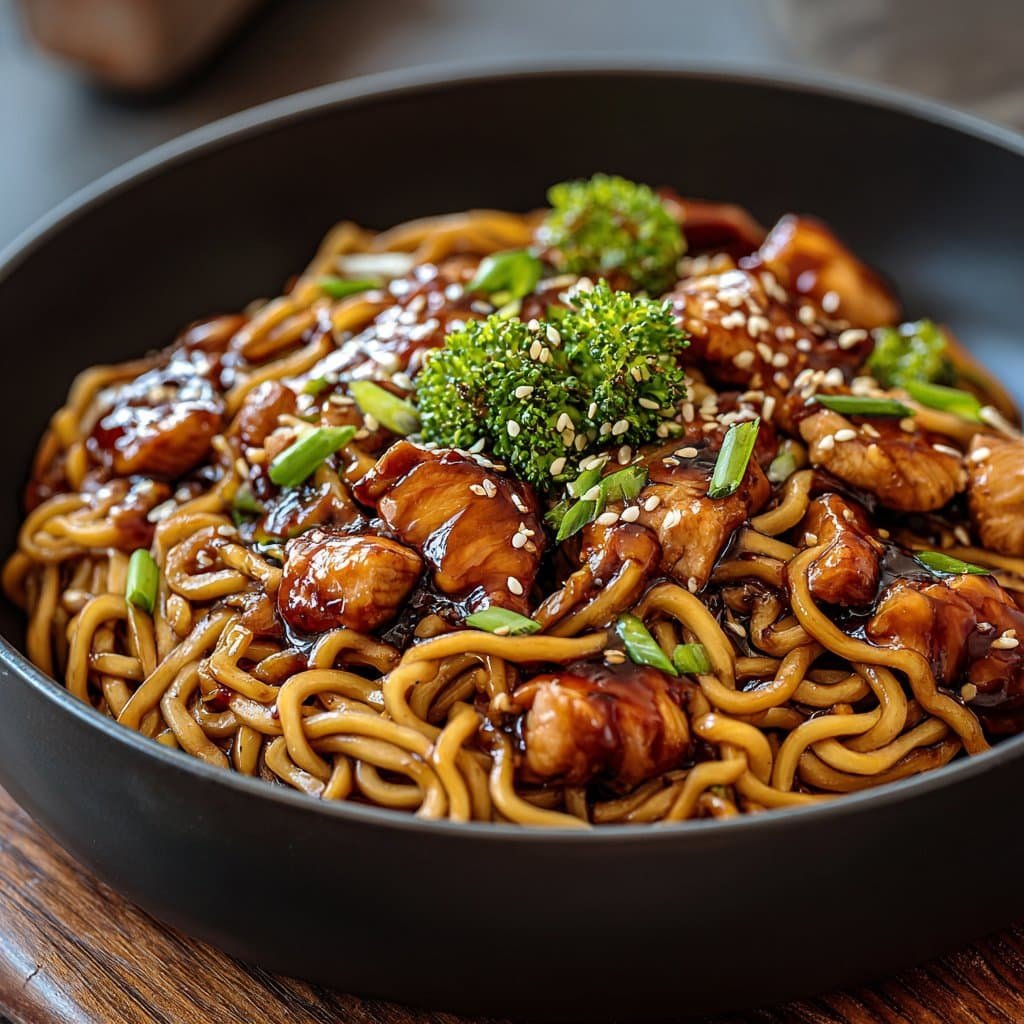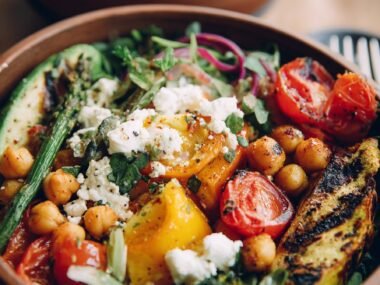If you turned up at my place on a Tuesday and asked what smells amazing, it is probably Chicken Teriyaki Noodles. I started making this when I was trying to impress a friend who claimed they could taste the difference between every soy sauce on earth. Spoiler, they could not, but we still wiped the pan clean. The sauce is shiny, the noodles are bouncy, and the chicken gets that caramel edge that makes me quietly proud in a very silly way.
I sometimes make this while half answering texts and half hunting for the sesame seeds, which means it is forgiving. And when the noodles slap the pan and go glossy, I do a tiny happy dance. Not mandatory, but recommended.
Why I keep cooking this on busy nights
I make this when the day has been a bit much and I want dinner that feels like a hug, not a faff. My family goes a bit mad for it because the sweet salty balance is spot on, and the noodles pick up the sauce like they were born for it. Also, I used to get annoyed at how noodles clump, then I learned to add a splash of noodle water to the pan and boom, crisis averted. Sometimes I add a handful of frozen peas and pretend it is virtue. It is not, but it is green.
(If you have ever had teriyaki sauce turn too thick and gummy, same. I did once. Actually, I find it works better if the cornstarch slurry is added off the direct heat, then brought back to a gentle bubble.)
What you need, plus what I swap when the cupboard looks bare
- 300 to 350 g dried noodles, something sturdy like udon or lo mein. I sometimes use spaghetti when I am in a hurry, it works fine and no one has complained yet.
- 500 g chicken thighs, sliced thin. Breast is fine too, just do not overcook it or it goes squeaky.
- 1 tablespoon neutral oil for the pan, plus a drizzle of sesame oil for finishing.
- 3 garlic cloves, minced. Granulated garlic can pinch hit if that is what you have.
- 1 tablespoon fresh ginger, grated. My grandmother always insisted on Brand X ginger paste, but honestly any decent paste works fine.
- 1 small carrot, matchsticks. Optional, but it adds a nice crunch.
- 1 cup small broccoli florets, or a handful of snap peas. Green is friendly here.
- 2 to 3 spring onions, sliced, whites and greens separated.
- Sesame seeds for finishing, a good sprinkle.
Quick teriyaki sauce
- 80 ml soy sauce. I like a classic brewed one; here is a handy guide I enjoy reading on Kikkoman.
- 2 tablespoons mirin. No mirin, no panic. Use 2 tablespoons rice vinegar plus 1 extra teaspoon sugar.
- 2 tablespoons brown sugar or honey. Honey makes it glossy, sugar gives a cleaner taste.
- 1 teaspoon sesame oil.
- 60 ml water or noodle cooking water.
- 2 teaspoons cornstarch stirred with 2 teaspoons cold water to make a slurry.
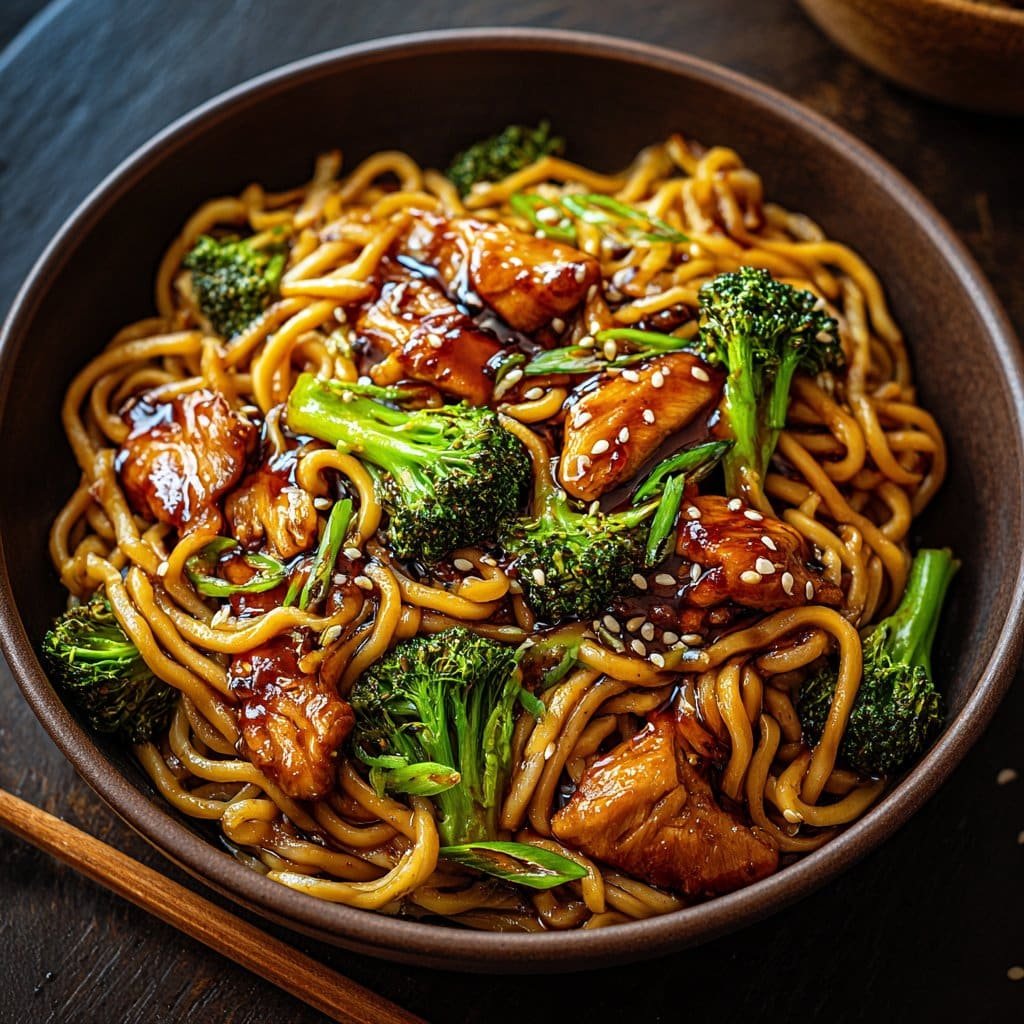
How I cook it, step by step-ish
- Prep your bits. Slice the chicken thin so it cooks fast. Mince the garlic and ginger. Mix the sauce ingredients except the cornstarch slurry in a jug so you feel organized for once.
- Boil the noodles in salted water until just shy of done, about 1 minute less than the packet says. Keep a mug of the cooking water, it is liquid gold. Drain the noodles and toss with a tiny splash of sesame oil so they do not clump while you faff about.
- Hot pan time. Heat a large wok or a big nonstick skillet until properly hot, add the oil, then the chicken in a single layer. Let it sit for 1 to 2 minutes to get a little color before stirring. This is where I usually sneak a taste. Season with a pinch of salt.
- Add the carrot, broccoli, and the white parts of the spring onions. Stir for a minute until bright and just tender.
- Push things to the side, add the garlic and ginger to the empty spot, give them a quick sizzle until fragrant. Stir everything together.
- Pour in the teriyaki mix. Let it bubble gently for 30 seconds. Stir the cornstarch slurry, add it in, and let the sauce thicken to a glossy coat. Do not worry if it looks a bit strange at this stage, it always does, then it suddenly turns shiny.
- Noodles go in. Toss toss toss. If it feels tight, splash in some noodle water until it loosens. You want saucy noodles that still cling, not soup.
- Finish with sesame oil, spring onion greens, and sesame seeds. Turn off the heat and let it sit for a minute so the noodles relax.
On second thought, you can add a pinch of chilli flakes if you like a little swagger. I usually do, then remember my kid side eyes me, and I add yoghurt to his bowl which is odd but it works, somehow.
Notes I learned the slightly messy way
- Thin chicken cooks fast. If you cut it chunky, give it an extra minute before adding veg.
- Stir the slurry right before adding. Cornstarch settles at the bottom and you get lumpy bits otherwise.
- Noodle water is your friend. It helps the sauce cling without turning stodgy. Do not skip that mug. I used to and the dish was fine, but this is better.
- If your sauce tastes harsh, a tiny knob of butter at the end softens the edges. Not traditional, but tasty.
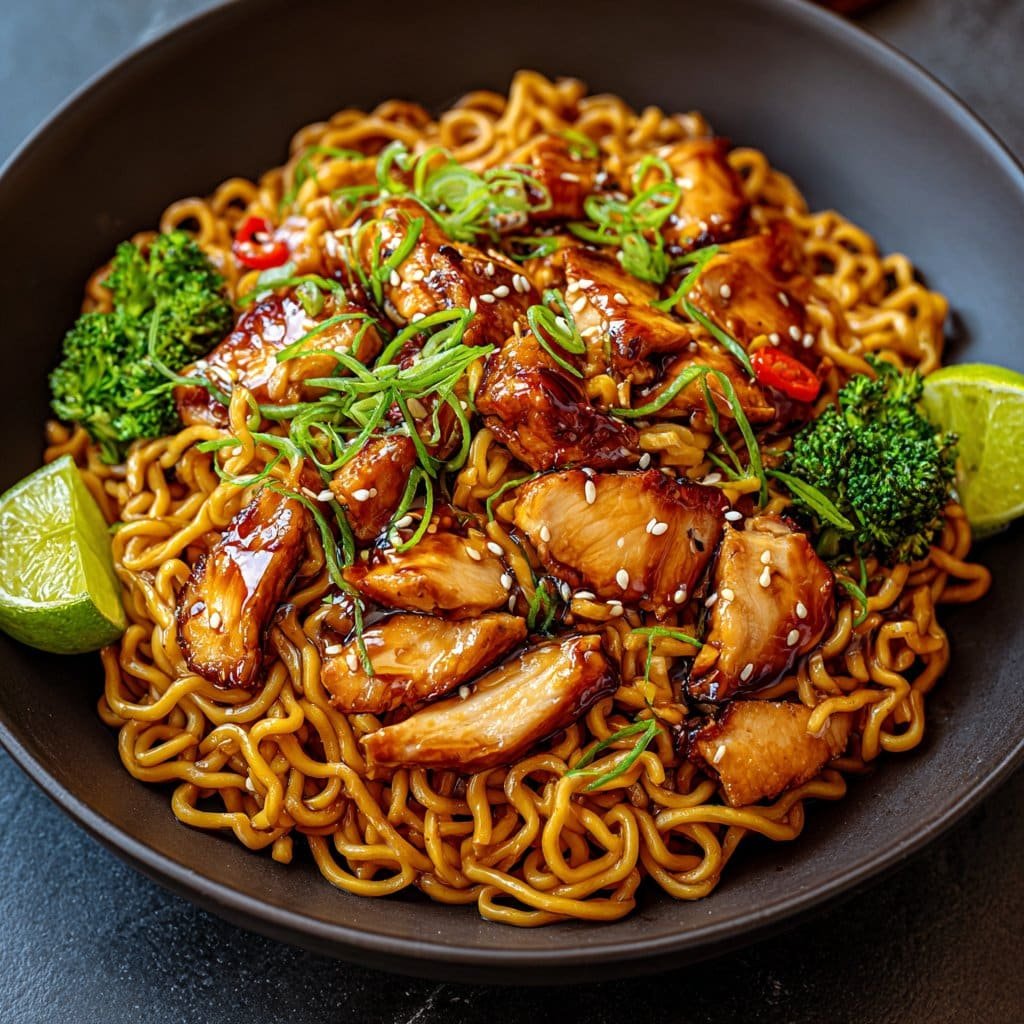
Variations I have tried so you do not have to guess
- Orange teriyaki twist: add the zest of half an orange and a squeeze of juice. Bright and cozy.
- Veg packed version: mushrooms and baby corn join the party. Add a splash of extra soy.
- Turkey instead of chicken: works nicely, though it dries quicker, so keep it saucy.
- One that did not quite work: courgette noodles. They turned watery and made the sauce thin. I thought I could wing it, but no, I loose the lovely glaze.
Gear I use, and what to do if you do not have it
- A wok makes tossing easy. If you do not have one, a big skillet or a heavy pot is fine. I have even used a roasting tin over two burners in a pinch. Bit chaotic, still tasted great.
- Tongs and a wooden spoon. Chopsticks help with the noodles, but honestly a fork works.
- A small jug for the sauce. Or any cup you can pour from. I have mixed it in a measuring mug while the kettle boils for a cuppa.
If you are curious about wok care, I like this friendly tutorial form The Woks of Life. Proper helpful.
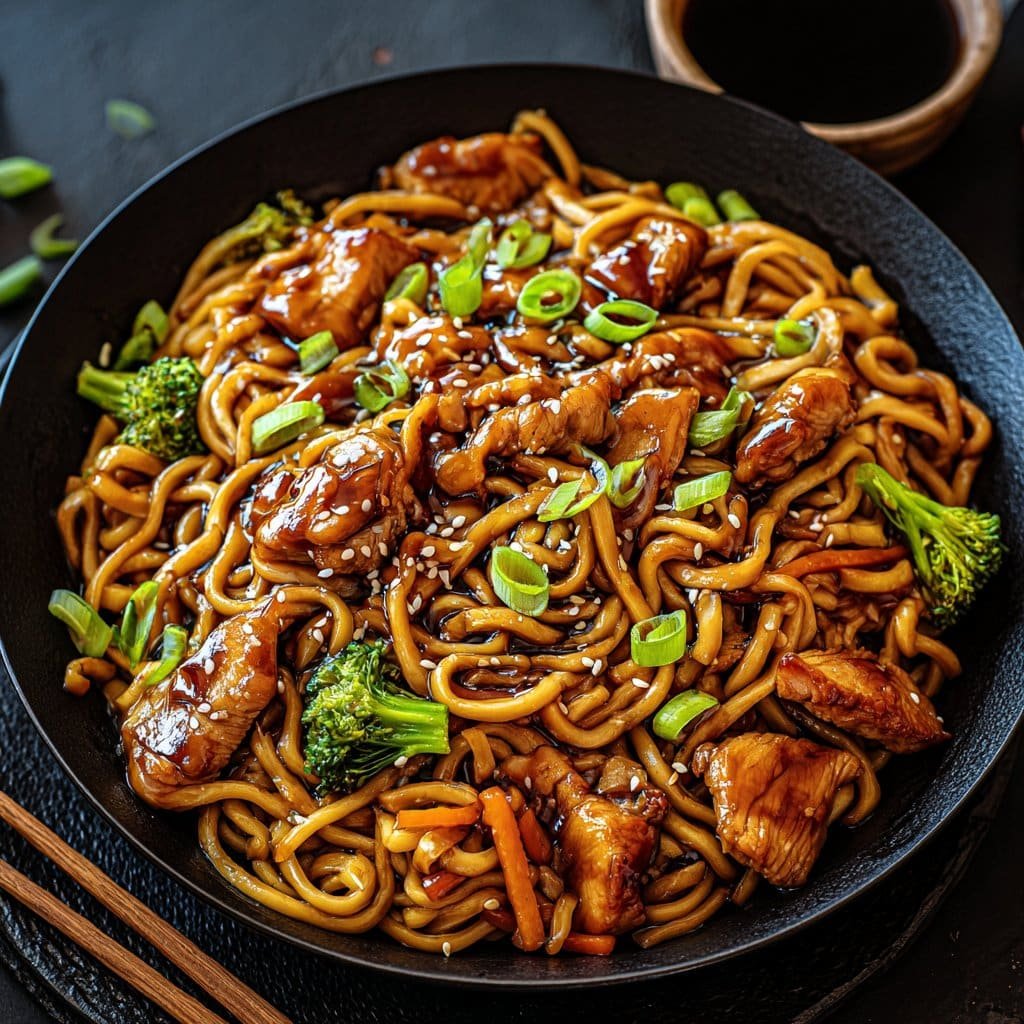
Storage, reheating, and my honest truth
Fridge: 3 to 4 days in a sealed container, though honestly, in my house it never lasts more than a day. Reheat in a pan with a splash of water until steamy. Microwave is fine too, stir halfway so the heat spreads.
Freezer: It is okay for up to one month, but the noodles can get a touch soft. I tend to think it tastes better the next day rather than next month.
What to serve with Chicken Teriyaki Noodles
- A crisp cucumber salad with rice vinegar and a pinch of sugar. Nice contrast.
- Pickled ginger if you have it. My cousin calls it the zingy confetti.
- Chilli crisp on the table so people can help themselves. We have a small tradition of arguing cheerfully over who gets the last spoon.
Tiny digression. I once watered my basil plant while the noodles boiled, then forgot I had taken the lid off the salt. Do not do that. Basil survived. Salt showered the counter. Dinner still rocked.
Pro tips, learned the hard way so you do not repeat my chaos
- I once tried rushing the browning step and regretted it because the chicken steamed and stayed pale. Give it that minute of calm in the hot pan.
- I added the slurry to a rolling boil and it clumped. Better to lower the heat, add slurry, then bring it back up gently.
- I thought more sugar meant more shine. It meant stickiness. Stick to the amounts, then adjust with water if needed.
FAQ I actually get about these noodles
Can I use bottled teriyaki sauce
Yes, of course. Start with about half a cup, then thin with a splash of water so it coats, not drowns. Taste and tweak.
What noodles are best
Thick wheat noodles like udon or lo mein hold up well. In a pinch, spaghetti works. If you want a deep dive on noodle types, this guide on Serious Eats is ace.
Gluten free option
Use tamari or a gluten free soy style sauce and swap in rice noodles or certified gluten free pasta. Keep an eye on timing, rice noodles cook fast.
Can I add vegetables
Absolutely, toss in peppers, mushrooms, or spinach. Add soft greens at the end so they do not vanish into nothingness.
Do I need mirin
No. A mix of rice vinegar and sugar gets you close. It is different, but lovely.
How do I keep leftovers from clumping
Stir in a tablespoon of water before reheating and fluff with tongs. A little oil helps too. Quick stir, then eat straight away.
Is chicken breast okay
Yes. Slice thin and cook just until opaque. Overcooked breast gets firm fast, so keep it saucy.
Ingredients
- 1 lb (450 g) boneless skinless chicken breast, thinly sliced
- 8 oz (225 g) fresh or dried udon or ramen noodles
- 1/3 cup (80 ml) soy sauce
- 2 tbsp mirin
- 2 tbsp brown sugar or honey
- 1 tbsp sesame oil
- 2 cloves garlic, minced
- 1 tbsp fresh ginger, grated
- 1 tbsp cornstarch mixed with 2 tbsp water (slurry)
- 1 tbsp vegetable oil for cooking
- 2 green onions, sliced (for garnish)
- 1 tbsp sesame seeds (for garnish)
Instructions
-
1Prepare the ingredients: thinly slice the chicken breast, mince the garlic, grate the ginger, and cook the noodles according to package instructions until al dente. Drain and set aside.
-
2Make the teriyaki sauce by whisking together soy sauce, mirin, brown sugar (or honey), sesame oil, garlic, and ginger in a small bowl.
-
3Heat vegetable oil in a large skillet or wok over medium-high heat. Add the sliced chicken and stir-fry until cooked through and lightly browned, about 4–6 minutes.
-
4Pour the teriyaki sauce into the skillet with the chicken. Bring to a simmer, then add the cornstarch slurry and cook until the sauce thickens and becomes glossy, about 1–2 minutes.
-
5Add the cooked noodles to the skillet and toss thoroughly to coat with the sauce and heat through, about 1–2 minutes. Adjust seasoning with a splash of water or soy sauce if needed.
-
6Serve immediately, garnished with sliced green onions and sesame seeds.
Approximate Information for One Serving
Nutrition Disclaimers
Number of total servings shown is approximate. Actual number of servings will depend on your preferred portion sizes.
Nutritional values shown are general guidelines and reflect information for 1 serving using the ingredients listed, not including any optional ingredients. Actual macros may vary slightly depending on specific brands and types of ingredients used.
To determine the weight of one serving, prepare the recipe as instructed. Weigh the finished recipe, then divide the weight of the finished recipe (not including the weight of the container the food is in) by the desired number of servings. Result will be the weight of one serving.
Did you make this recipe?
Please consider Pinning it!!
